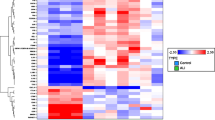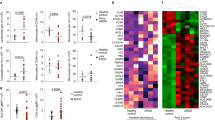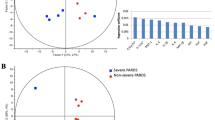Abstract
Background
The acute respiratory distress syndrome (ARDS) represents a form of severe acute inflammatory lung disease. We have previously demonstrated significantly raised interleukin-8 (IL-8) levels in the lungs of at-risk patients that progress to ARDS, and identified the alveolar macrophage as an important source of this chemokine. We wished to extend this study in a well-defined group of patients with major trauma, and to investigate potential mechanisms for rapid intrapulmonary IL-8 generation.
Materials and Methods
Patients with major trauma underwent brochoalveolar lavage (BAL) and IL-8 levels were measured in BAL fluid by ELISA. Human macrophages were derived from peripheral blood monocytes from healthy volunteers. Rabbit alveolar macrophages were obtained from ex-vivo lavage of healthy rabbit lungs. Macrophages were culture under normoxic or hypoxic (PO2 26 mmHg) conditions. IL-8 and other proinflammatory mediator expression was measured by ELISA, northern blotting or multi-probe RNase protection assay.
Results
In patients with major trauma, IL-8 levels were significantly higher in patients that progressed to ARDS compared to those that did not (n = 56, P = 0.0001). High IL-8 levels negatively correlated with PaO2/FiO2 (r = −0.56, P < 0.001). In human monocyte derived macrophages hypoxia rapidly upregulated IL-8 protein (within 2 hours) and mRNA expression (within 30 mins). Acute hypoxia also increased rabbit alveolar macrophage IL-8 expression. Hypoxia increased DNA binding activity of AP-1 and C/EBP but not NF-κB. Hypoxia induced HIF-1 expression, but cobaltous ions and desferrioxamine did not mimic hypoxic IL-8 induction. Hypoxia downregulated a range of other proinflammatory mediators, including MCP-1 and TNF-α. Both the pattern of cytokine expression and transcription factor activation by hypoxia was different to that seen with endotoxin.
Conclusions
Rapidly raised intrapulmonary IL-8 levels are associated with ARDS progression in patients with major trauma. Acute hypoxia, a clinically relevant stimulus, rapidly and selectively upregulates IL-8 in macrophages associated with a novel pattern of transcription factor activation. Acute hypoxia may represent one of potentially several proinflammatory stimuli responsible for rapid intrapulmoanry IL-8 generation in patients at-risk of ARDS.











Similar content being viewed by others
References
Tate RM, Repine JE. (1983) Neutrophils and the adult respiratory distress syndrome. Am Rev. Respir. Dis. 128: 552–559.
Repine JE. (1992) Scientific perspectives on the adult respiratory distress syndrome. Lancet 339: 466 (Abstract).
Ware LB, Matthay MA. (2000) The Acute Respiratory Distress Syndrome. N. Engl. J. Med. 342: 1334–1349.
Milberg JA, Davis DR, Steinburg KP, Hudson LD. (1995) Improved survival of patients with acute respiratory distress syndrome (ARDS): 1983–1993. JAMA. 273: 306–309.
Fowler AA, Hamman RF, Good JT, et al. (1983) Adult respiratory distress syndrome: risk with common predispositions. Ann. Intern. Med. 98: 593–597.
Donnelly SC, Strieter RM, Kunkel SL, et al. (1993) Interleukin-8 and development of adult respiratory distress syndrome in at-risk groups. Lancet 341: 643–647.
McColm JR, McIntosh N. (1994) Interleukin-8 in bronchoalveolar lavage samples as predictor of chronic lung disease in premature infants. Lancet 343: 643–647.
Khan TZ, Wagener JS, Bost T, et al. (1995) Early pulmonary inflammation in infants with cystic fibrosis. Am. J. Respir. Crit. Care. Med. 4: 939–941.
Fisher AJ, Donnelly SC, Hirani N, et al. (2001) Elevated levels of interleukin-8 in donor lungs is associated with early graft failure after lung transplantation. Am. J. Respir. Crit. Care. Med. 163: 259–265.
Baker JW, Deitch EA, Li M, et al. (1988) Haemorrhagic shock induces bacterial translocation from the gut. J. Trauma. 28: 896–906.
Parsons PE, Worthen GS, Moore EE, et al. (1989) The association of circulating endotoxin with the development of the adult respiratory distress syndrome. Am. Rev. Respir. Dis. 140: 294.
Baker SP, O’Neill B. (1976) The Injury Severity Score: an update. J. Trauma 16: 882–885.
Martin TR, Rubenfeld GD, Ruzinski JT, et al. (1997) Realtionship between soluble CD14, lipopolysaccharide binding protein, and the alveolar inflammatory response in patients with acute respiratory distress syndrome. Am. J. Respir. Crit. Car. Med. 155: 937–944.
Haslett C, Guthrie LA, Kopaniac MM, et al. (1985) Modulation of multiple neutrophil functions by preparative methods or trace concentrations of bacterial lipopolysaccharide. Am. J. Physiol. 119: 101–111.
Savill JS, Wylie AH, Henson JE, et al. (1989) Macrophage phagocytosis of ageing neutrophils in inflammation: Programmed cell death in the neutrophil leads to its recognition by macrophages. J. Clin. Invest. 83: 865.
Yoshimura T, Yuhki N. (1991) Neutrophil attractant/activation protein-1 and monocyte chemoattractant protein-1 in rabbit: cDNA cloning and their expression in spleen cells. J. Immunol. 146: 3483–3488.
Wiesener MS, Turley H, Allen WE, et al. (1998) Induction of endothelial PAS domain protein-1 by hypoxia: characterization and comparison with hypoxia-inducible factor-1α. Blood 92: 2260–2268.
Wang GL, Jiang B, Rue EA, Semenza GL. (1995) Hypoxiainducible factor 1 is a basic-helix-loop-helix-PAS heterodimer regulated by cellular O2 tension. Proc. Natl. Acad. Sci. USA 92: 5510–5514.
Goldberg MA, Dunning SP, Bunn HF. (1988) Regulation of the erythropoeitin gene: Evidence that the oxygen sensor is a heme protein. Science 242: 1412–1415.
Gleadle JM, Ebert BL, Firth JD, Ratcliffe PJ. (1995) Regulation of angiogenic growth factor expression by hypoxia, transition metals, and chelating agents. Am. J. Physiol. 268: C1362–C1368.
Melillo G, Taylor LS, Brooks A, et al. (1997) Functional requirement of the hypoxia-responsive element in the activation of the inducible nitric oxide synthase promotor by the iron chelator desferrioxamine. J. Bio. Chem. 272: 12236–12243.
Lok CN, Ponkas P. (1999) Identification of a hypoxia responsive element in the transferrin receptor gene. J. Bio. Chem. 274: 24147–24152.
Murray JF, Matthay MA, Luce JM, Flick MR. (1988) Pulmonary Perspectives. An expanded definition of the adult respiratory distress syndrome. Am. Rev. Respir. Dis. 138: 720–723.
Miller EJ, Cohen AB, Nagao S, et al. (1992) Elevated levels of NAP-1/interleukin-8 are present in the airspaces of patients with adult respiratory distress syndrome and are associated with increased mortality. Am. Rev. Respir. Dis. 146: 427–432.
Chollet-Martin S, Montravers P, Gibert C, et al. (1993) High levels of interleukin-8 in the blood and alveolar spaces of patients with pneumonia and adult respiratory distress syndrome. Infect. Immun. 61: 4553–4559.
Torre D, Zeroli C, Giola M, et al. (1993) Levels of interleukin-8 in patients with adult respiratory distress syndrome. J. Infect. Dis. 167 (2): 505–506.
Holter JF, Weiland JE, Pacht ER, Gadeck JE, Davis WB. (1986) Protein permeability in the adult respiratory distress syndrome: loss of size selectivity of the alveolar epithelium. J. Clin. Invest. 78: 1513–1522.
Steinberg KP, Milberg JA, Martin TR, et al. (1994) Evolution of bronchoalveolar cell populations in the adult respiratory distress syndrome. Am. J. Respir. Crit. Care. Med. 148: 556–561.
Donnelly SC, Strieter RM, Reid PT, et al. (1996) The association between mortality rates and decreased concentrations of interleukin-10 and interleukin-1 receptor antagonist in the lung fluids of patients with the adult respiratory distress syndrome. Ann. Int. Med. 125: 191–196.
McGuire WW, Spragg RC, Cohen AB, Cochrane CG. (1982) Studies in the pathogenesis of the adult respiratory distress syndrome. J. Clin. Invest. 69: 543–553.
Kunkel SL, Standiford TJ, Kashara K, Strieter RM. (1991) Interleukin-8 (IL-8): the major neutrophil chemotactic factor in the lung. Exp. Lung. Res. 17: 17–23.
Goodman RB, Strieter RM, Martin DP, et al. (1996) Inflammatory cytokines in patients with persistence of the acute respiratory distress syndrome. Am. J. Respir. Crit. Care. Med. 154: 602–611.
Sekido N, Mukaida N, Harada A, et al. (1993) Prevention of lung reperfusion injury in rabbits by a monoclonal antibody against interleukin-8. Nature 365: 654–657.
Nakamura M, Fujishima S, Makoto S, et al. (2000) Importance of interleukin-8 in the development of reexpansion lung injury in rabbits. Am. J. Respir. Crit. Care. Med. 161: 1030–1036.
Folkesson HG, Matthay MA, Hebert CA, Broaddus VC. (1995) Acid aspiration-induced lung injury in rabbits is mediated by interleukin-8-dependent mechanisms. J. Clin. Invest. 96: 107–116.
Bowden DH, Adamson IYR. (1980) Role of monocytes and interstitial cells in the generation of alveolar macrophages. Lab. Invest. 5: 511–517.
Blusse van Oud Alblas A, van der Linden-Schrever B, van Furt, R. (1983) Origin and kinetics of pulmonary macrophages during an inflammatory reaction induced by intra-alveolar administration of aerosolized heat-killed BCG. Am. Rev. Respir. Dis. 128: 276–281.
Ungar J, Wilson GR. (1985) Monocytes as a source of alveolar macrophages. Am. J. Pathol. 11: 681–691.
Julien M, Lemoyne B, Denis R, Malo J. (1987) Mortality and morbidity related to severe intrapulmonary shunting in multiple trauma patients. J. Trauma 27: 970–973.
Silverston P. (1989) Pulse oximetry at the roadside: a study of pulse oximetry in immediate care. Br. Med. J. 298: 711–713.
Vlessis AA, Trunkey DD. (1997) Non-penetrating injury of the thorax. In: Scientific foundations of trauma, Cooper GJ, Dudley HAF, Gann DS, et al., eds., Butterworth Heinemann, Oxford, UK, pp. 127–143.
Mizushima Y, Hiraide A, Shimazu T, et al. (2000) Changes in contused lung volume and oxygenation in patients with pulmonary parenchymal injury after blunt chest trauma. Am. J. Emerg. Med. 18: 385–389.
Karakurum M, Shreeniwas R, Chen J, et al. (1994) Hypoxic induction of interleukin-8 gene expression in human endothelial cells. J. Clin. Invest. 93: 1564–1570.
Tamm M, Bihl M, Eikelberg O, et al. (1998) Hypoxia-induced interleukin-6 and interleukin-8 production is mediated by platelet-activating factor and platelet-derived growth factor in primary human lung cells. Am. J. Respir. Cell. Mol. Biol. 19: 653–661.
Mukaida N, Mahe Y, Matsushima K. (1990) Cooperative interaction of nuclear factor-kB- and cis-regulatory enhancer binding protein-like factor binding elements in activating the interleukin-8 gene by pro-inflammatory cytokines. J. Bio. Chem. 265: 21128–21133.
Kunsch C, Lang RK, Rosen CA, Shannon MF. (1994) Synergistic transcriptional activation of the IL-8 gene by NFkB p65 (RelA) and NF-IL6. J. Immunol. 153: 153–164.
Roger T, Out TA, Mukaida N, et al. (1998) Enhanced AP-1 and NF-kB activities and stability of interleukin 8 (IL-8) transcripts are implicated in IL-8 mRNA superinduction in lung epithelial H292 cells. Biochem. J. 330: 429–435.
Lakshminarayanan V, Drab-Weiss EA, Roebuck KA. (1998) H2O2 and tumour necrosis factor-alpha induce differential binding of the redox responsive transcription factors AP-1 and NF-kappaB to the interleukin-8 promotor in endothelial and epithelial cells. J. Biol. Chem. 273: 32670–32678.
Roebuck KA, Carpenter LR, Lakshminarayanan V, et al. (1999) Stimulus-specific regulation of chemokine expression involves differential activation of the redox responsive transcription factors AP-1 and NF-kappaB. J. Leukoc. Biol. 65: 291–298.
Yao K, Xanthoudakis S, Curran T, O’Dwyer PJ. (1994) Activation of AP-1 and of a nuclear redox factor, Ref-1, in the response of HT29 colon cancer cells to hypoxia. Mol. Cell. Biol. 14: 5997–6003.
Bandyopadhyay RS, Phelan MW, Faller DV. (1995) Hypoxia induces AP-1-regulated genes and AP-1 transcription factor binding in human endothelial and other cells types. Biochem. Biophys. Acta 1264: 72–78.
Rupec RA, Baeuerle PA. (1995) The genomic response of tumour cells to hypxia and reoxygenation. Differential activation of transcription factors AP-1 and NF-kB. Eur. J. Biochem. 234: 632–640.
Yan SF, Tritto I, Pinsky D, et al. (1995) Induction of interleukin 6 (IL-6) by hypoxia in vascular cells. Central role of the binding site for nuclear factor-IL-6. J. Biol. Chem. 270: 11463–11471.
Yan SF, Zou YS, Medelsohn M, et al. (1997) Nuclear factor interleukin 6 motifs mediate tissue-specific gene transcription in hypoxia J. Biol. Chem. 272: 4287–4294.
Yoshida A, Yoshida S, Khalil AK, Inomata H. (1998) Role of NF-kB-mediated interleukin-8 expression in intraocular neovascularization. Invest. Ophthalmol. Vis. Sci. 39: 1097–1106.
Chandel NS, Tryzna, WC, McClintock DS, Schumacker PT. (2000) Role of oxidants in NF-kB activation and TNF-α gene transcription induced by hypoxia and endotoxin. J. Immunol. 165: 1013–1021.
Mukaida N, Shiroo M, Matsushima K. (1989) Genomic structure of the human monocyte-derived neutrophil chemotactic factor IL-8. J. Immunol. 143: 1366–1371.
Gleadle JM, Ratcliffe PJ. (1998) Hypoxia and the regulation of gene expression. Mol. Med. Today 4: 122–129.
Acknowledgments
NH and SCD are supported by The Wellcome Trust, UK.
Author information
Authors and Affiliations
Corresponding author
Additional information
Communicated by R. Bucala.
Rights and permissions
About this article
Cite this article
Hirani, N., Antonicelli, F., Strieter, R.M. et al. The Regulation of Interleukin-8 by Hypoxia in Human Macrophages—A Potential Role in the Pathogenesis of the Acute Respiratory Distress Syndrome (ARDS). Mol Med 7, 685–697 (2001). https://doi.org/10.1007/BF03401959
Accepted:
Published:
Issue Date:
DOI: https://doi.org/10.1007/BF03401959




